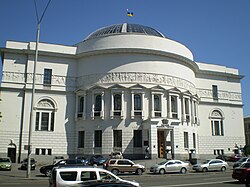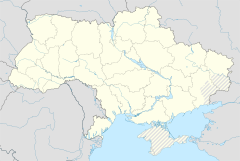Kyiv City Teacher's House
| Kyiv City Teacher's House | |
|---|---|
Київський міський будинок учителя | |
 | |
| General information | |
| Type | National Landmark of History |
| Location | Kyiv |
| Country | Ukraine |
| Coordinates | 50°26′41″N 30°30′49″E / 50.444758°N 30.513512°E |
| Opened | 1912 |
| Design and construction | |
| Architect(s) | Pavlo Alyoshyn |


The Kyiv City Teacher's House (Ukrainian: Київський міський будинок учителя) also known as the Central Council House (Ukrainian: Будинок Центральної Ради) is a historical building located at 57 Volodymyrska Street, in Kyiv, Ukraine. The building is located next to the "Yellow Building" of Taras Shevchenko National University of Kyiv and the Presidium Building of National Academy of Sciences of Ukraine.
Currently, it is mainly occupied by the Ukrainian Trade Union of workers of Education and Science in Kyiv. It also houses the Pedagogical museum, the museum of Ukrainian Revolution (1917-1920), the State Pedagogical and Science Library of Sukhomlynsky, and the Cultural Center "Kyianochka". Both museums are located on the second floor.
The building was constructed during the Imperial era in 1909-1911 by Pavlo Alyoshyn.[1]
Scope
Originally, the building was built in 1912 for the Kyiv Pedagogical Museum that existed since 1901 and was located until 1913 in a building of the
The Pedagogical museum was revived in 1977 based on the Republican pedagogical exhibition that existed since 1948. In 1982 it finally returned to its original building and is located on the second floor at the south wing. The museum is administrated by the Academy of Pedagogical Sciences of Ukraine.
The building is a property of Kyiv City. Along with a few municipal offices located there, a part of the building is currently subleased for office space by a set of political, civil, and small business organizations.
"Ukrainian Club" meeting place
The Ukrainian Club (
In 1912, the Kyiv City Council had closed the Ukrainian Club, accusing it of subversive activity. But soon, another Ukrainian society, Rodyna, was arranged in the same building where the former Ukrainian Club met. When the city's administration gave permission to organize the Rodyna club, it was assumed that the stress mark was on the first syllable meant motherland, Rodina. However, the members of the club always called it Rodyna (translated as family in Ukrainian).[3]
Bibliography
- Malikenaite, Ruta (2003). Touring Kyiv. Baltia Druk. p. 50. ISBN 966-96041-3-3.
References
- ^ Drug,O.M., Malakov,D.V. Kyiv's mansions. "Kyi". Kyiv, 2004.
- ^ Building of Pedagogical Museum at interesniy.kiev.ua Archived 2011-07-22 at the Wayback Machine (in Ukrainian)
- ^ "Файл:Kievlyanin 1912 277.pdf — Вікіпедія" (PDF). commons.wikimedia.org (in Ukrainian). Retrieved 2022-07-04.
External links
- Building of Pedagogical Museum at Kiev's WEK encyclopedia (in Ukrainian)
- Brief overview at www.ch20.org (in Ukrainian)

